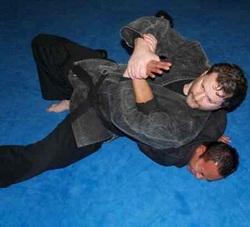| Ninjutsu Melbourne - Bujinkan Melbourne Ninjutsu |
Ninja Blog
Thoughts and ideas related to training in
Bujinkan Ninjutsu
|
Ninjutsu Alive training, in my opinion just what does that mean. Martial arts training is essentially about learning new skills, some skills you can practice by yourself and for others you may need a training partner or even several training partners to develop the skill being taught by your instructor. So lets look at a few things we can do by ourselves and then others that we may need a training partner to complete the exercise.
Your training partner should be relaxed and compliant i.e. go with your technique in order to help you learn how to apply a lock for example, it’s partnered so it’s a lot closer to real life . They allow you the time you need to apply the lock or do the throw etc without interfering …..But is that alive. Sparring is a lot closer to reality, in that instead of being a rehearsed training drill each person is more free with their responses, for example a training drill might start with a lapel grab and strike to the head and then after that the training partner is (in a responsible way) able to continue on with any attack that they see fit to use, it might be more punches or maybe a kick , they might try to throw you to the ground or get around behind you to apply a constriction. With more spirit and conviction, and resistance to your techniques if they choose. Their goal is still to help you learn what to do, just under more real to life circumstances. So why not jut train like that from day one I hear you ask. Good question, the reason is that in order to learn how to apply a technique first you must learn the technique itself. This is best done by repetition on a compliant training partner, the more techniques then the longer it takes you to get your skill set together. At Ninjutsu Melbourne around half way (2 years ish) to black belt we invite the student to participate in what we call pressure testing and sparring, although to my mind it’s not typical sparring. There is still a nominated attacker and defender it’s just that the attacks are not nominated.
Having developed the basic building blocks (Kihon Happo etc) of their training they are able to start to learn how to apply it under pressure. The partner’s goal is to push the students hard enough with resistance so that they succeed 80% of the time and just as importantly fail 20% of the time. At first it’s fairly slow and awkward but over a period of time it improves and after about 6 months they really are up and running with it. This shows us where the student might be in relation to being able to apply a technique in real life. Over time keeping the 80/20 scenario going they build speed until eventually they can apply most techniques at real time in a safe and controlled way. In the past we have introduced this type of training a lot earlier but what we have noticed is that the student goes back to brawling and abandons their techniques, so it defeats the purpose which is to help them learn how to apply their training in a real life situation. If the student starts to abandon technique then we make them slow it down so that as they improve and get faster they can take technique with them, 80/20 remember. Attacker too fast, student brawls and abandons their technique in order to win , attacker too slow student doesn’t learn anything about being under pressure. 80% success 20% fail is about right. So in order to see the progression from basic dojo training right through to real life I’ve put together a simple number of steps.
This is just a really quick overview and I might write more about it at a later date. The great thing about this type of training is that you don’t need to do it very often, we only train this way once a week for about 15 minutes and it’s not compulsory. Got a comment, question or want to share it around , feel free to add it to your facebook feed. www.ninjutsumelbourne.com.au
0 Comments
Your comment will be posted after it is approved.
Leave a Reply. |
AuthorCraig Guest 20+ years Bujinkan Training ArchivesCategories
All
Ninjutsu Blog updates via RSS
Click to subscribe
|
Thornbury - 272 Dundas St

 RSS Feed
RSS Feed